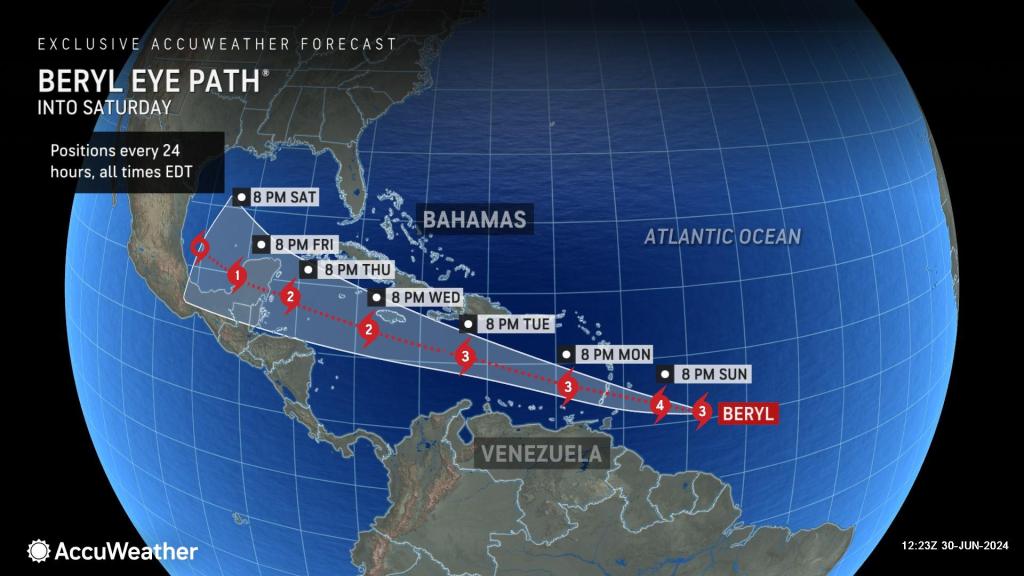
Beryl continues to strengthen as it charges toward the Caribbean, becoming the first hurricane of the 2024 season. AccuWeather meteorologists warn it could intensify into a Category 4 by the start of the week.
With hurricane season kicking into gear, now is the time to stock up on hurricane supplies.
Hurricane Beryl is gaining strength as it charges toward the Caribbean where it is predicted to strike with powerful winds and flooding storm surge. Beryl reached hurricane status on Saturday afternoon with Category 1 winds of 75 mph just 24 hours after the system was first formed as a tropical depression over the Atlantic Ocean. As of 8 a.m. EDT Sunday, Beryl had become a major Category 3 hurricane with sustained winds of 115 mph, and it was heading west at 20 mph, a brisk pace for a hurricane.
AccuWeather meteorologists are expecting that the storm will continue to undergo rapid intensification, becoming the first Category 4 hurricane in the Atlantic (sustained winds of at least 130 miles per hour) before reaching the Windward Islands early this week.
“Beryl continues to strengthen as it moves toward the Lesser Antilles, as the environment around the storm is becoming more conducive,” said AccuWeather Lead Hurricane Forecaster Alex DaSilva.
GET THE FREE ACCUWEATHER APP
-
Have the app? Unlock AccuWeather Alerts™ with Premium+
Due to the threat, the Meteorological Service of Barbados issued a hurricane warning for the island Saturday afternoon. Late Saturday morning, hurricane watches were issued by other government agencies to include St. Lucia, St. Vincent and the Grenadine Islands and Grenada.
“The storm will continue to be steered west-northwestward across the Caribbean Sea by a large area of high pressure through the middle of [this] week,” said DaSilva.
AccuWeather began referring to the system as a tropical rainstorm on Thursday to help raise public awareness of the risk to lives and property along the storm’s path.
As Beryl tracks west, higher-than-historical-average water temperatures will be one of the primary factors leading to the potential for continued rapid intensification.
AccuWeather has been anticipating a super-charged hurricane season for 2024 since this past winter
Interaction with the larger islands of the Caribbean as well as bouts of wind shear and dry air may still become inhibiting factors to the storm reaching its full potential. However, AccuWeather meteorologists now expect that the impact of these factors will be minimal, allowing Beryl to become a major hurricane by Monday and maintain this status beyond that into the southern Caribbean.
The AccuWeather RealImpact™ Scale for Hurricanes is a 4 for the Lesser Antilles in the eastern Caribbean, with the expectation that the storm will become a Category 4 (maximum sustained winds of 130-156 mph) by the time that it reaches those islands. As Beryl continues to the west-northwest, additional numbers will be issued on the AccuWeather RealImpact™ Scale for Hurricanes as it approaches other land masses.
Beyond its trek through the Caribbean, all eyes will turn toward the United States. At this point, AccuWeather hurricane experts expect the U.S. to avoid impacts from the storm. That being said, residents should not let their guard down.
“At this point, the most likely scenario is for the storm to move westward into Mexico; however, it is very important to note that if the high pressure across the Southeast weakens, that can allow the storm to move farther north and potentially directly impact the Gulf Coast,” explained DaSilva.
Tropical storms and hurricanes in the central and eastern Atlantic are rare this early in the season. This area of the Atlantic, known as the main development region, does not typically spawn tropical storms and hurricanes until mid-August or later.
Peak Timing / Frequency of Hurricane Season
Beryl may not be the last early-season tropical storm or hurricane to form in the central or eastern Atlantic Ocean. AccuWeather hurricane experts are monitoring another area of potential development to the east of Beryl.
“This storm is expected to follow a track very similar to Beryl and can be near the Lesser Antilles around July 3-4 and could eventually bring very heavy rain to portions of the Greater Antilles,” warned DaSilva.
Besides Beryl and another potential developing storm behind it, there is a third area being monitored closer to the U.S. An area of showers and thunderstorms is located over the Yucatan Peninsula, and its projected path will cross nearly the same locations where Tropical Storm Alberto tracked earlier this month. However, it may run out of time.
“This area of thunderstorms will have a very short development window on Sunday before it moves inland into Mexico on Sunday night. Regardless of development, very heavy rain can cause dangerous flooding and mudslides across portions of northeastern Mexico,” cautioned DaSilva.
The tropical Atlantic could potentially become calmer for a time after this week, but the season is not even a month old yet, and more storms will form throughout the remainder of the season.
Report a Typo